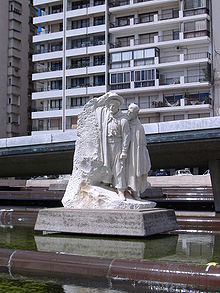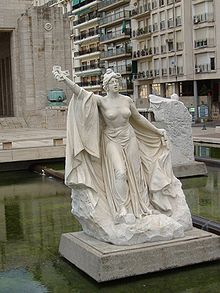- Lola Mora
-
Lola Mora (17 November 1866 – 7 June 1936) was a sculptor, born in a farm in the province of Salta, Argentina, though generally considered native to Trancas, province of Tucumán, where she was recorded and baptized. She is known today as a rebel and a pioneer of women in her artistic field. Her real name was Dolores Mora Vega.
Lola Mora was the daughter of Romualdo Alejandro Mora, a prosperous landowner of Tucumán. She was also a goddaughter of Nicolás Avellaneda and a protégé of Julio Argentino Roca.
At 20 years of age she began painting portraits, but soon turned to sculpting marble and granite. She studied art in her home province and then, with a scholarship, in Rome, Italy, where she created her greatest works, some of them by request of the Argentine government. In 1900 she was charged with creating two bas-reliefs for the Historical House of Tucumán (seat of Argentina's Declaration of Independence of 1816).
Her style and exposure were controversial and rebellious. In 1903 her The Nereids Fountain, created for the city of Buenos Aires, met bureaucratic problems at the city's Deliberative Council, which had the sculpture moved from place to place.
Near the end of her life, she did some extravagant business (such as financing petroleum surveys in Salta), and then retired with only a pension to support herself. After her death in Buenos Aires, in poverty and obscurity, friends of hers burned her letters, mementos and personal diaries.
Although it is not commonly known, Lola Mora obtained various patents. One included a system to project films without a screen (using a column of vapor), as well as systems for mining.[1]
Works
Some of Lola Mora's works are:
- The above mentioned bass-reliefs at the House of Tucumán, with the themes of the May Revolution's First National Government and the Declaration of Independence.
- A Statue of Liberty, also in San Miguel de Tucumán.
- The The Nereids Fountain, now located at Costanera Sur, Buenos Aires, and the Avellaneda Memorial.
- Several sculpture groups placed in the historic center of Rosario, flanking the way to the propylaeum of the National Flag Memorial.
- Four allegoric sculptures called Peace, Justice, Liberty and Progress, originally created for the National Congress building, but then placed around the building of the Government House of San Salvador de Jujuy.
Sources
- VisiteTuc.com - A site about Tucumán.
- Practicosas.com.ar - A women's site with a romantic biography.
- Municipality of Jujuy - Official website.
- Universidad Nacional de Rosario - Pictures of the Oath Passage in Rosario, flanked by Lola Mora's sculptures.
References
Categories:- Argentine sculptors
- People from Salta Province
- 1866 births
- 1936 deaths
- Argentine inventors
Wikimedia Foundation. 2010.




